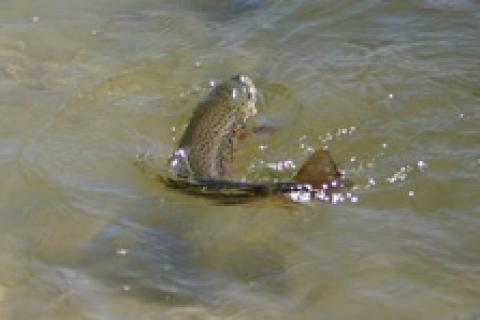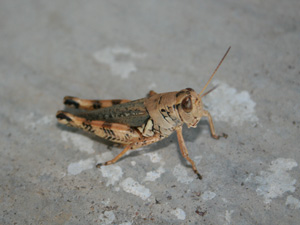
The circle of ripples on the smooth water had my undivided attention. Then, when a silvery trout broke through the river's calm surface and landed with a flashy splash, I had a much better idea of what fly to tie onto the end of my tippet and how to effectively fish the water before me. Moments spent scouting the water transformed into more catches during the hours that followed — and no frustration. It pays to read the water.
 |
| Take a hike and scout rivers, lakes and streams before rushing to begin casting. |
For too many anglers a fly-fishing trip begins with a hurried arrival in a parking lot or by the water, then a flurry of tugging on waders, pulling lines through rod eyes, and a mad dash for the river or stream. Slow down! A fly-fishing trip is supposed to be an escape from bothersome computers, traffic and phones. And slow down and scout to get important pointers on the "where, what and how to fish" the water before making that first cast. You'll find this is time well invested.
Take a Hike & Scout for Trout
Fly fishing is popular, and most lakes, streams and rivers that hold trout have well-worn trails along the water's edge. To tug more trout from those waters, you should take the time to follow the trails and do some scouting much like you do when planning a deer hunt. Look for habitat, food sources and trout. Note waterfalls, deep pools and places that trout like to lurk on your brief pre-fishing hike. You can also wear sunglasses and use binoculars to spot fish while you hide in the shadows or behind brush so fish don't spot you. Scouting also reveals woody debris in the water, grasses and sandbars, and gives a good indication of stream flow rates. All can help you plan your wading and casting tactics.
Next, you should look on the water, in the air, and into the vegetation while scouting for insects and trout food sources. When I saw small dark midges clinging to a streamside snowbank on an early March fly-fishing scouting trip, I had a good idea of what to tie on. My discovery brought many rainbows to hand that day. Insects can also be spotted hanging on leaves, floating on scum and bits of brush, or clinging to rocks.
It also pays big rewards to look in the calmer back of eddies and in tranquil waters behind sandbars for possible food sources. While closely looking into one Midwest river I noted lots of crayfish, including some orange ones, in the graveled bottom. A short while later my orange crayfish imitation pattern caused a lunker brown trout to surrender to the hook.
You should pay close attention to the size and color of the food sources you discover so you can work to make a near perfect match. You can also carry a magnifying glass in your gear and make a close-up study of any captured insect if you want an accurate understanding of what to cast and what size fly to use. Trout often key on shapes and sizes overhead when surface feeding, and you need to make the match to find success.
And when insects swarm into the skies, like some caddis and mayfly hatches are prone to do, birds take note and take wing. So should you. Look for birds that fly and dip sharply, or make direct trips up from perches on limbs to grab passing insects. A binocular stashed in your fly vest or gear can help you see what is in the air —or across the river in a bush.
While compact binoculars could help you gain a better view, I opt for midsized models (7X35 and 8X42mm) that are easier to hold and offer a wider view and possibly more magnification. You will need to determine how much weight you are willing to stash in a vest or pack, and how much does each item contribute to your fishing success. If you get into the habit of using a binocular when fly fishing, you'll never be without one. And thanks to today's optics manufacturing capabilities you can purchase binoculars that weigh less than 20 ounces but are heavy on features and functions. And, yes, the model you tote along should at least be waterproof!
 |
| The best indicator for active fishing is when you spot a feeding trout. |
And another big clue about what should be tied to the end of your tippet comes from spotting what particular insect species a trout rises to. There could be many insects out on the water, so which one do the trout prefer? Stop and observe the water and rising trout to avoid the old time consuming trail-and-error method most anglers follow in frustration. And while some anglers will spot the larger salmon flies and surmise that's the favored fish food, they could miss noting that trout are actually feeding on nearly microscopic Tricoes. It pays to pause and observe.
Some sources suggest that you catch a trout and pump its stomach to determine the content. Again, you have to actually catch the trout, and that could be a time consuming and maddening affair if you've rushed to the water after your arrival and begun flailing fly line.
Look, Over There You Might Find Trout!
At times taking a hike to scout water before rigging up to begin fly fishing can be a time consuming — or impossible — chore. Rivers running through the bottom of a canyon or backcountry lake cannot be easily scouted prior to leaving the parking lot. And when you have several rivers or fishing sites close to each other, where should you fish? The answer can be found in power scouting.
The tactic means driving and checking waters — and anglers — from lake-side parking lots, river overlooks, and bridges where there is little traffic. You can glass from the vehicle or walk to the edge of the lot before scanning the country and water. The sight of splashy trout and anglers using landing nets will soon help you determine what water to cast over.
From a high river overlook in Montana one morning I was glassing for trout and observing downstream anglers as I scouted for clues on where and what to fish that day. As I watched the many unsuccessful anglers who were also in an open field and fighting stiff winds with each cast, I saw a silver flash nearby. A closer glance through my binocular revealed many trout in a feeding frenzy in a sharp river bend immediately downstream from the bridge. The calm water was protected from wind by a steep, high bank and a localized hatch was underway. No angler was anywhere close to that area. My discovery yielded many trout during the following hours. The other frustrated anglers had walked past the location.
Search for Indicators of What the Area Offers as Food for Trout
 |
| If you see a grasshopper, you know what the fish are interested in. |
In addition to looking into the water for clues of what trout are feeding on, also look around you. You'll need to be a detective and search for indicators of what the stream or river has to offer up as food. One place I always focus my attention, something other anglers eagerly brush aside, is spider webs. These sticky mazes capture a lot of insects and can provide many clues on what's in the air locally. If you arrive in the early morning hours and see a mayfly struggling for freedom, a closer look for shimmering drops of dew might reveal if it just became entangled recently or was there overnight.
And while you're looking around in the bushes, you might find clues of what other anglers have been casting. You'll possibly spot a new local fly pattern hooked in a tree branch. Just don't waste too much time pulling out old flies; there's fishing to be done, and that's why you're by the water.
Remember also that your first glimpse at what a fish grabs could be misleading. If many trout are surface feeding because of a huge hatch that's underway, that is often easy to spot and clue in on. And if you don't have the pattern that closely resembles the insect that is most favored, you might need to make a quick trip to a fly shop before you wade in.
Pre-Trip Trout Scouting
Fly fishing success often hinges on proper scouting, and some scouting chores are best done before you leave home — or most certainly before you reach the river, stream or lake. Your fishing trip — especially to a new area or distant body of water — should generally always begin with an internet search of the many sites with hatch charts and stream reports. You can also browse the Web pages of local fly shops for recommendations, images and trip reports. Then make a call or plan visits to those shops to inquire about patterns currently in favor.
Once you've gathered the details, only then is it time to rush to the stream. Hurry, there are hungry trout waiting to be caught!
- 6387 views

